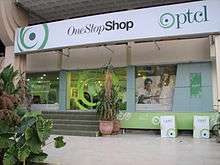ptcl
 | |
| Private, Public | |
| Traded as | KSE: PTC |
| Industry | Telecommunications |
| Genre | Telecommunication |
| Founded | 1949[1] |
| Headquarters | Islamabad, Islamabad Capital Venue, Pakistan |
Key people |
Dr. Daniel Ritz (President, CEO) Azamat Ali Ranjha (Chairman) Taimur Qadar Khattak (SEVP, CFO) Tariq Salman (CTO) |
| Products |
Wireless Telephone Internet IPTV |
| Revenue |
|
|
| |
| Owner |
Pakistan government (62%) Etisalat Telecommunications (26%) |
| Subsidiaries | Ufone GSM |
| Website |
www |
Pakistan Telecommunication Company Limited (PTCL) is the leading telecommunication company in Pakistan. The company provides telephonic and Internet services nationwide and is the backbone for the country's telecommunication infrastructure despite the arrival of a dozen other telecommunication corporations, including Telenor Corps and China Mobile Ltd. The corporation manages and operates around 2000 telephone exchanges across the country, providing the largest fixed-line network. Data and backbone services such as GSM, HSPA+, CDMA, LTE, broadband Internet, IPTV, and wholesale are an increasing part of its business.
Originally one of the state-owned corporations (SOEs), the share holding of PTCL was reduced to ≈62%, when 26% of shares and control was sold to Etisalat Telecommunications and the remaining 12% to the general public in 2006 under an intensified privatization programme of prime minister Shaukat Aziz. However, the 62% of shares still remain under the management of government-ownership of state-owned corporations (SOEs) of Pakistan.
History
From the beginning of the Posts & Telegraph Department in 1949[1] and establishment of Pakistan Telephone & Telegraph Department in 1962, PTCL has been a major player in telecommunication in Pakistan.
Pakistan Telecommunication Corporation (PTC) took over operations and functions from Pakistan Telephone and Telegraph Department under Pakistan Telecommunication Corporation Act 1991. This coincided with the Government's competitive policy, encouraging private sector participation and resulting in award of licenses for cellular, card-operated pay-phones, paging and, lately, data communication services.
Pursuing a progressive policy, the Government in 1991, announced its plans to privatize PTCL, and in 1994 issued six million vouchers exchangeable into 600 million shares of the would-be PTCL in two separate placements. Each had a par value of Rs. 10 per share. These vouchers were converted into PTCL shares in mid-1996.
In 1995, Pakistan Telecommunication (Reorganization) Ordinance formed the basis for PTCL monopoly over basic telephony in the country. The provisions of the Ordinance were lent permanence in October 1996 through Pakistan Telecommunication (Reorganization) Act. The same year, Pakistan Telecommunication Company Limited was formed and listed on all stock exchanges of Pakistan
PTCL launched its mobile and data services subsidiaries in 2001 by the name of Ufone and PakNet respectively. None of the brands made it to the top slots in the respective competitions. Lately, however, Ufone had increased its market share in the cellular sector. The PakNet brand has effectively dissolved over the period of time. Recent DSL services launched by PTCL reflects this by the introduction of a new brand name and operation of the service being directly supervised by PTCL.

As telecommunication monopolies head towards an imminent end, services and infrastructure providers are set to face even bigger challenges. The post-monopoly era came with Pakistan’s Liberalization in Telecommunication in January 2003. On the Government level, a comprehensive liberalization policy for telecoms sector is in the offering.
In 2005, Government of Pakistan decided to sell 26 percent of this company to some private corporation. There were three participants in the bet for privatization of PTCL. Etisalat, a Abu Dhabi-based company was able to get the shares with a large margin in the bet.[3] Government's plan of privatizing the corporation were not welcomed in all circles; countrywide protests and strikes were held by PTCL workers. They disrupted phone lines of institutions like Punjab University Lahore along with public sector institutions were also blocked. Military had to take over the management of all the exchanges in the country.[4] They arrested many workers and put them behind bars. The contention between Government and employees ended with a 30% increase in the salaries of workers.
Products
PTCL is a part of the consortium of three major Submarine communication cable networks: SEA-ME-WE 3, SEA-ME-WE 4 and I-ME-WE.
Voice
PTCL provides its fixed line telephone services in many cities of Pakistan.
Vfone Network Shutdown
Voice services used to be provided through PTCL's CDMA2000 network, which was broadcast over the 1900 MHz WLL frequency under the 'Vfone' brand name, however the network was shut down on 31 August 2016 nationwide.[5]
Internet / High Speed Broadband
Being Pakistan's largest ADSL2+ provider, PTCL primarily provides its customers with ADSL broadband, however as demand for higher bandwidth connections has increased, PTCL is upgrading its customers to VDSL2 and FTTH GPON in a few major cities, namely Karachi, Lahore, Islamabad, Rawalpindi and Peshawar.
Wireless
Wireless options are also available under the 'EVO Nitro' or 'CharJi Evo' brand names. The former being based on EvDo Rev A and B, and the latter using LTE technology. This is done using PTCL's 1900 MHz WLL frequency that was previously used for their Vfone CDMA2000 network. There is seamless LTE coverage in Karachi, Lahore, Rawalpindi and Islamabad, whereas there is coverage for EvDo Rev B (up to 9.3 Mbps) in the remaining 200+ cities.
Ufone GSM is also a wholly owned subsidiary of PTCL, it also the 3rd largest cellular provider in the country. It provides both GSM and HSPA+ services over the 900, 1800 and 2100 MHz bands.[6]
IPTV
In addition to these services, PTCL also offers one of the world's first commercial Digital HD TV services based on DVB-IPTV with the brand name of Smart TV.[7] PTCL users can also stream live TV using the SmartTV application for Windows and Android OS.[8]
Company profile
PTCL is the largest telecommunications provider in Pakistan. PTCL also continues to be the largest CDMA operator in the country with 0.8 million V-fone customers. The company maintains a leading position in Pakistan as an infrastructure provider to other telecom operators and corporate customers of the country. It has the potential to be an instrumental agent in Pakistan’s economic growth. PTCL has laid Optical Fibre Access Network in the major metropolitan centres of Pakistan and local loop services have started to be modernized and upgraded from copper to an optical network. On the Long Distance and International infrastructure side, the capacity of two SEA-ME-WE submarine cable is being expanded to meet the increasing demand of International traffic.[9]
Change in Number format
PTCL had started with 10 digit numbers for digital telephones. The first three (in case of smaller cities, 4 or 5) signified the area code (e.g. 042 for Lahore) and the rest (7 for large cities, 6 or 5 for smaller ones) were the subscriber's number. Due to the large demand for landlines in Lahore and Karachi, in 2009, PTCL decided to increase the 7-digit subscriber numbers to 8-digits, adding "9" before existing Government numbers and "3" before the others (e.g. the number 042-7878787 before 2009, was changed to 042-37878787).[10]
Controversy with Nayatel and Bahria Town CCP notice
Ever since Nayatel started offering its FTTH (Fiber-To-The-Home) services in the twin cities, PTCL has lost a substantial amount of market share in this region due to Nayatel offering more services under one brand, and at competitive prices.
In August 2016, a complaint from a resident of Bahria Town (Pvt. Ltd) was forwarded to the CCP which revealed that Bahria Town was deliberately preventing other fixed line service providers from expanding into Bahria Town, and thus giving PTCL the majority of the market share in the housing society, not to mention it was in violation of the Competition Act (2010) by abusing its dominant position and entering into a prohibited agreement.[11][12]
Six months later, CCP imposed a fine to Bahria Town of 2 Million PKR for deliberately not issuing a NOC (No-Objection Certificate) to Nayatel in Phases 1 to 6.[13]
Bahria Town has been directed to work with Nayatel to lay down its Fiber Optic cable network in Phases 1 to 6.[14][15][16]
See also
- List of dialling codes of Pakistan
- National Telecommunication Corporation - Previously part of TNT.
- PTCL Smart TV
- Telephone numbers in Pakistan
- Ufone - Wholly owned cellular subsidiary of PTCL
References
- 1 2 "PTCL Company Profile". LinkedIn. Retrieved 2 July 2017.
- 1 2 "PTCL Annual Report 2015" (PDF). PTCL.com.pk. Retrieved 17 April 2016.
- ↑ "Pakistan on Monday accepted an offer by Emirates Telecommunications Corp", June 21, 2005, indianexpress.com
- ↑ "Troops take control of key PTCL installations", 13 June 2005, Gulf Times
- ↑ "Vfone Closure". ptcl.com.pk. Retrieved 2017-03-15.
- ↑ "Company Profile". www.ptcl.com.pk. Retrieved 2017-03-15.
- ↑ "Better than Cable - PTCL Smart TV". www.ptcl.com.pk. Retrieved 2017-03-15.
- ↑ "Smart TV App". www.ptcl.com.pk. Retrieved 2017-03-15.
- ↑ PTCL Website - Company Information
- ↑ "PTCL changes numbers to 8 digits in Karachi, Lahore". 7 June 2009. Retrieved 30 January 2017.
- ↑ "CCP Issues Show Cause Notice to Bahria Town for Blocking Nayatel in Rawalpindi". 2016-08-04. Retrieved 2017-02-07.
- ↑ "CCP issues show-cause notice to Bahria Town for abuse of dominance". The Nation. Retrieved 2017-02-07.
- ↑ "CCP Fines Bahria Town for Not Allowing Nayatel to Operate in It". Today's Pak.com- Pakistan & World Latest News. 2017-02-07. Retrieved 2017-02-07.
- ↑ Desk, News. "Competition Commission imposes Rs 2m fines on Bahria Town | Profit by Pakistan Today". Retrieved 2017-02-07.
- ↑ Zulqernain. "CCP fines Bahria Town for misusing its dominant position". www.outlookpakistan.com. Retrieved 2017-02-07.
- ↑ "CCP Fines Bahria Town for Not Allowing Nayatel to Operate in It". 2017-02-07. Retrieved 2017-02-07.